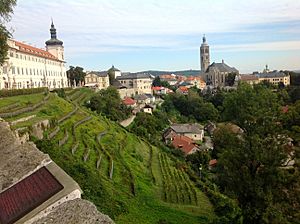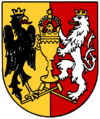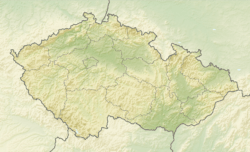Kutná Hora facts for kids
Quick facts for kids
Kutná Hora
|
|||
|---|---|---|---|
|
Town
|
|||

Vineyard of Kutná Hora
|
|||
|
|||
| Country | |||
| Region | Central Bohemian | ||
| District | Kutná Hora | ||
| First mentioned | 1289 | ||
| Area | |||
| • Total | 33.07 km2 (12.77 sq mi) | ||
| Elevation | 254 m (833 ft) | ||
| Population
(2024-01-01)
|
|||
| • Total | 21,556 | ||
| • Density | 651.83/km2 (1,688.23/sq mi) | ||
| Time zone | UTC+1 (CET) | ||
| • Summer (DST) | UTC+2 (CEST) | ||
| Postal code |
284 01
|
||
| UNESCO World Heritage Site | |||
| Official name | Historical Town Centre with the Church of St Barbara and the Cathedral of Our Lady at Sedlec | ||
| Criteria | ii, iv | ||
| Inscription | 1995 (19th Session) | ||
Kutná Hora (Czech pronunciation: [ˈkutnaː ˈɦora]; German: Kuttenberg) is a town in the Central Bohemian Region of the Czech Republic. It has about 22,000 inhabitants. The centre of Kutná Hora, including the Sedlec Abbey and its ossuary, was designated a UNESCO World Heritage Site in 1995 because of its outstanding architecture and its influence on subsequent architectural developments in other Central European city centres. Since 1961, the town centre is also protected by law as an urban monument reservation, the fourth largest in the country.
Contents
Administrative parts
The town is made up of twelve town parts and villages:
- Kutná Hora-Vnitřní Město
- Hlouška
- Kaňk
- Karlov
- Malín
- Neškaredice
- Perštejnec
- Poličany
- Sedlec
- Šipší
- Vrchlice
- Žižkov
Etymology
The name of the town was derived from the eponymous mountain (hora = 'mountain'). According to legends, the name of the mountain was derived from the monks' cowls (the Kutten). It is more likely that it derived from the Middle High German word kutte ('pit'). The name can also be derived from the Czech words kutit ('to work') or kutat ('to mine'), but the Czech origin of the name is less likely.
Geography
Kutná Hora is located about 52 kilometres (32 mi) east of Prague. The eastern part of the municipal territory lies in a flat agricultural landscape of the Central Elbe Table lowland. The western part lies in the Upper Sázava Hills and includes the highest point of Kutná Hora, the hill Malý Kuklík at 359 m (1,178 ft) above sea level. The Vrchlice Stream flows through the town.
History
Bronze Age and Iron Age
Archaeological finds show that the area around the Kaňk hill was populated by Celts during the Hallstatt and La Tène periods. At the Celtic settlement site between Libenice and Kaňk, numerous ceramic finds from the 5th–1st century BC were discovered in 1981. One of the most important finds is a smelting furnace with 10 kg of slag from the 2nd–1st century BC with traces of pyrrhotine, chalcopyrite, sphalerite and copper, which also testify to early underground mining in the Kaňk hill.
Establishment
The earliest traces of silver have been found dating back to the 10th century, when Bohemia already had been in the crossroads of long-distance trade for many centuries. Silver dinars have been discovered belonging to the period between 982 and 995 in the settlement of Malín, which is now a part of Kutná Hora.
The town began in 1142 with the settlement of Sedlec Abbey, the first Cistercian monastery in Bohemia. The Cistercian order based in the Sedlec Monastery was brought from the Imperial immediate Cistercian Waldsassen Abbey in Bavaria, close to the border with Bohemia. By 1260, German miners began to mine for silver in the mountain region, which they named Kuttenberg, and which was part of the monastery property.
Middle Ages
From the 13th to 16th centuries, the town competed with Prague economically, culturally, and politically. Under Abbot Heinrich Heidenreich, the territory greatly advanced due to the silver mines which gained importance during the economic boom of the 13th century.
In 1300, King Wenceslaus II of Bohemia issued the new royal mining code Ius regale montanorum (also known as Constitutiones Iuris Metallici Wenceslai II). This was a legal document that specified all administrative as well as technical terms and conditions necessary for the operation of mines. Prague groschen were minted between 1300 and 1547/48.
In December 1402, the town was sacked by King Sigismund after the imprisonment of Wenceslaus IV. It was heavily defended by its residents. After several bloody skirmishes, Sigismund prevailed and forced the defenders to march to Kolín and kneel in subjugation. Although Sigismund was successful in his conquest, his hetman Markvart of Úlice died after being struck by an arrow during the siege on 27 December.
The town developed with great rapidity, and at the outbreak of the Hussite Wars in 1419 was the second most important town in Bohemia after Prague, having become the favourite residence of several Bohemian kings. It was here that, on 18 January 1409, Wenceslaus IV signed the famous Decree of Kutná Hora, by which the Czech university nation was given three votes in the elections to the faculty of Prague University as against one for the three other nations.
In 1420, Sigismund made the town the base for his unsuccessful attack on the Taborites during the Hussite Wars, leading to the Battle of Kutná Hora. Kutná Hora was taken by Jan Žižka, and after a temporary reconciliation of the warring parties was burned by the imperial troops in 1422, to prevent its falling again into the hands of the Taborites. Žižka nonetheless took the place, and under Bohemian auspices it awoke to a new period of prosperity.
Modern era
Along with the rest of Bohemia, Kuttenberg (Kutná Hora) passed to the Habsburg monarchy of Austria in 1526. In 1546, the richest mine was severely flooded. In the insurrection of Bohemia against Ferdinand I the town lost all its privileges. Repeated visitations of the plague and the horrors of the Thirty Years' War completed its ruin. Half-hearted attempts after the peace to repair the ruined mines failed; the town became impoverished, and in 1770 was devastated by fire. The mines were abandoned at the end of the 18th century.
In May 1742 during the First Silesian War, a Prussian force under Frederick the Great stopped in the town prior to the Battle of Chotusitz.
Bohemia was a crownland of the Austrian Empire in 1806, and remained controlled by the Austrian monarchy after the compromise of 1867. Until 1918, the town was the capital of the district of the same name, one of the 94 Bezirkshauptmannschaften in Bohemia. Together with the rest of Bohemia, the town became part of the newly founded Czechoslovakia after World War I and the collapse of Austria-Hungary.
Demographics
| Historical population | ||||||||||||||||||||||||||||||||||||||||||||||||||||||||
|---|---|---|---|---|---|---|---|---|---|---|---|---|---|---|---|---|---|---|---|---|---|---|---|---|---|---|---|---|---|---|---|---|---|---|---|---|---|---|---|---|---|---|---|---|---|---|---|---|---|---|---|---|---|---|---|---|
|
|
|
||||||||||||||||||||||||||||||||||||||||||||||||||||||
| Source: Censuses | ||||||||||||||||||||||||||||||||||||||||||||||||||||||||
Sights
Sedlec is the site of the Gothic Church of the Assumption of Our Lady and Saint John the Baptist and the famous Sedlec Ossuary. It is estimated that the ossuary is decorated with bones of more than 40,000 skeletons.
Among the most important buildings in the town are the Gothic, five-naved St. Barbara's Church, begun in 1388, and the Italian Court, formerly a royal residence and mint, which was built at the end of the 13th century.
The Gothic Stone House, which since 1902 has served as a museum of silver, contains one of the richest archives in the country. The Gothic Church of Saint James the Great, with its 86 m (282 ft) tower, is another prominent building.
Other sights include:
- Jesuit College
- Plague Column
- Church of St. John of Nepomuk
- Church of Saint Ursula's Convent
- Church of Saint Stephan in Malín
Notable people
- Bohuslav Bílejovský (c. 1480–1555), historian and theologian
- Jakob Jakobeus (1591–1645), Slovak writer
- Václav Bernard Ambrosi (1723–1806), painter
- Jan Erazim Vocel (1803–1871), poet, archaeologist and historian
- Josef Kajetán Tyl (1808–1856), dramatist and writer, author of the national anthem
- Antonín Lhota (1812–1905), painter and art teacher
- Felix Jenewein (1857–1905), painter and illustrator
- Gabriela Preissová (1862–1946), writer and playwright
- Emanuel Viktor Voska (1875–1960), intelligence agency officer
- Karel Domin (1882–1953), botanist and politician
- Jaroslav Vojta (1888–1970), actor
- Vera Prasilova Scott (1899–1996), Czech-American photographer and sculptor
- František Zelenka (1904–1944), architect, graphic, stage set and costume designer
- Jiří Orten (1919–1941), poet
- Zbyněk Zbyslav Stránský (1926–2016), museologist
- Radka Denemarková (born 1968), writer and translator
- Alena Mills (born 1990), ice hockey player
Twin towns – sister cities
Kutná Hora is twinned with:
 Bingen am Rhein, Germany
Bingen am Rhein, Germany Eger, Hungary
Eger, Hungary Fidenza, Italy
Fidenza, Italy Jajce, Bosnia and Herzegovina
Jajce, Bosnia and Herzegovina Kamianets-Podilskyi, Ukraine
Kamianets-Podilskyi, Ukraine Kremnica, Slovakia
Kremnica, Slovakia Reims, France
Reims, France Ringsted, Denmark
Ringsted, Denmark Stamford, England, United Kingdom
Stamford, England, United Kingdom Tarnowskie Góry, Poland
Tarnowskie Góry, Poland
Gallery
-
Black Death memorial
See also
 In Spanish: Kutná Hora para niños
In Spanish: Kutná Hora para niños














